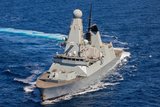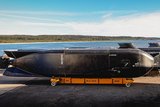CAMM 3-cell ExLS completes qualification trials
MBDA and Lockheed Martin have completed qualification of MBDA’s Common Anti-air Modular Missile (CAMM) from Lockheed Martin’s Extensible Launching System (ExLS) 3-cell standalone launcher following a series of trials.
ExLS leverages the design and electronics of Lockheed Martin’s Mk 41 Vertical Launching System (VLS).
The compact vertical launch 3-cell ExLS system has been designed specifically for smaller naval platforms that are unable to accommodate the larger 8-cell MK 41 VLS. ExLS is also designed to fit inside the ExLS Host MK 41 launcher, offering flexible, adaptable installation solutions for larger ships to achieve high combat mass within a small on-board footprint.
CAMM is a highly compact missile that enables multiple weapons to be fitted in limited spaces. When operated from ExLS or MK 41 VLS, CAMM comes in a quad-pack arrangement which enables a single cell to store and fire four missiles.
Joe DePietro, VP of small combatants and ship systems, Lockheed Martin: ‘The success of these trials is testament to the hard work and close co-operation of MBDA and Lockheed Martin. A launcher within a launcher, ExLS uses CAMM canistered munitions with its qualified launch electronics to cut integration costs by more than 50%.
‘It is a mature design that when paired with CAMM offers a low-cost alternative for integrating new missiles and munitions into current and future surface combatants.’
Related Equipment in Defence Insight
More from Naval Warfare
-
![US Coast Guard prepares procurement of next-gen surface search radar]()
US Coast Guard prepares procurement of next-gen surface search radar
The NXSSR will replace five in-service capabilities and be the US Coast Guard’s primary collision avoidance system.
-
![MBDA-led DragonFire’s latest trials move the LDEW system closer to UK Navy integration]()
MBDA-led DragonFire’s latest trials move the LDEW system closer to UK Navy integration
The DragonFire lines up with other European laser-directed energy weapons being developed in collaboration with MBDA.
-
![US Coast Guard pursues solutions to increase maritime domain dominance]()
US Coast Guard pursues solutions to increase maritime domain dominance
The USCG is seeking technologies, services and applications to better connect its assets and speed up the decision-making process.
-
![Canadian Coast Guard’s OOSV delivery is “major milestone” in fleet modernisation]()
Canadian Coast Guard’s OOSV delivery is “major milestone” in fleet modernisation
The Polar Class 6 platform is the largest CCG science-dedicated vessel and will operate on the country’s east coast.
-
![How the Anduril-HHI autonomous ship plan fits in with the US Navy’s MASC programme]()
How the Anduril-HHI autonomous ship plan fits in with the US Navy’s MASC programme
The new modular vessel is expected to be developed for both commercial and defence use, with a heavy focus on production speed and mission flexibility.























